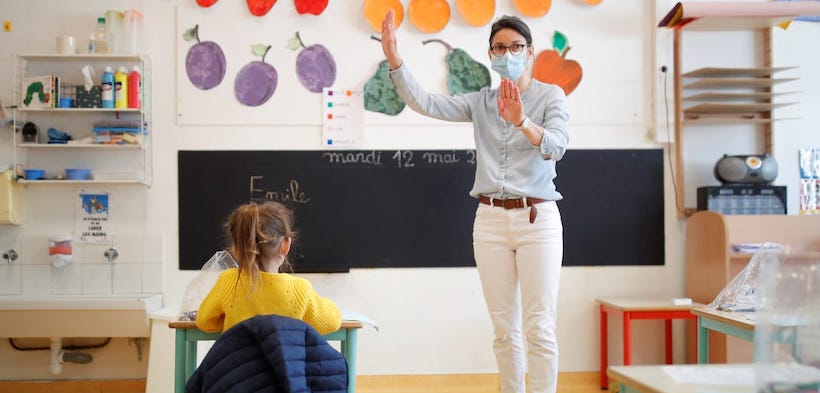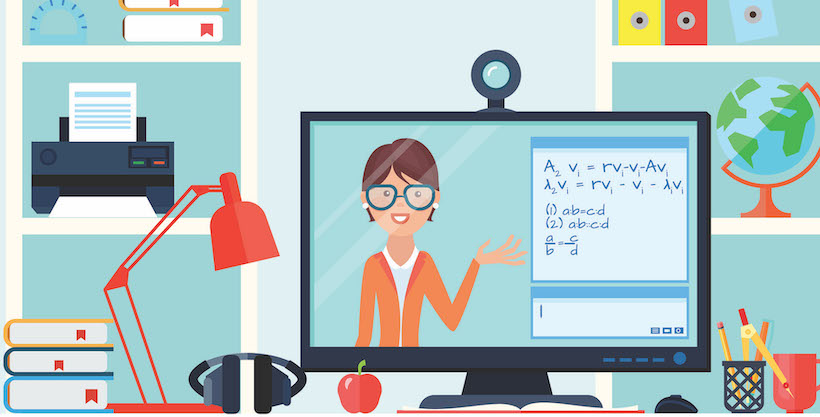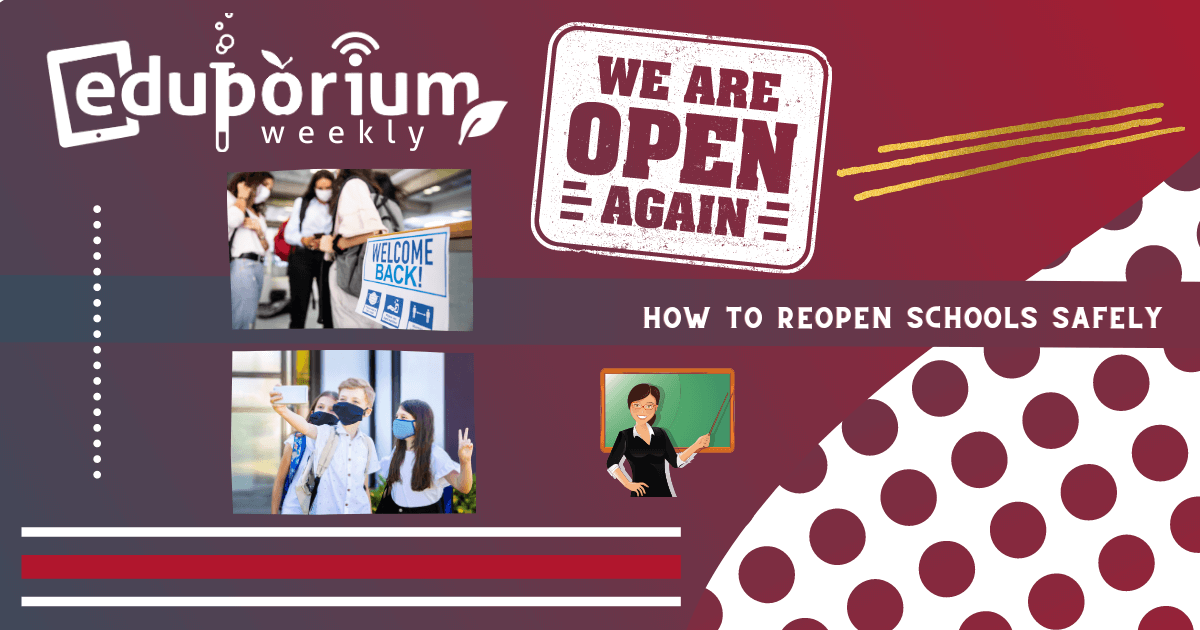It’s getting closer to school beginning in many parts of the county meaning that school reopening plans are becoming finalized. To add clarity, when we say reopening, it doesn't necessarily mean that learning will be physically taking place in person. Reopenings may include one of three likely scenarios: in-person learning, hybrid learning, and fully remote learning. When school doors physically closed in March, we certainly did not think that things would still be in such a state of uncertainty come August, but the reality is that almost all school leaders are preparing for a back-to-school season unlike ever before. So, with school reopening plans starting take shape, let's look at what might work, where we're heading, and what's next.
Going Back to School: So Many Factors
We’re monitoring news of school reopening plans and, like everybody else, learning about what education might look like. While many students don’t go back to school until the beginning of September, others do traditionally begin each year in mid-August or sooner, meaning that they’re heading back real soon. We’ve heard that, for some districts, the first day of school is delayed by a week or two allowing for just a little bit more time to test safety protocols or for educators to finalize their instructional plans. We’ve also heard not so encouraging news about a student who returned to school and tested positive the same day. While that is likely to happen often, we’re trying to keep a positive attitude as all of this unfolds.
Reopening plans in just about every district will be unique with caveats relevant to geographical, economic, environmental, and other factors. In rural areas, for example, it may be easier to bring everyone back since more might safely fit in classrooms. In an urban school, however, it's basically impossible for every student to return full-time with the distancing measures in place. School and district leaders have been in constant communication with parents and teachers throughout the summer trying to get as much feedback as they can about what everyone’s thinking and worried about. There are so many factors for safely reopening in-person schooling and it seems like somebody is always coming up with new thoughts or shedding some new light on the situation—something we'd expect with so much fluidity in getting back to classrooms.
We read about one plan that will be go into effect in New York. Like other plans, it includes its own unique wrinkles, but it’s also unique in general. Leaders in the district decided to go with a hybrid approach, which is certainly a popular choice at this moment. They surveyed parents during the summer to get feedback on their thoughts, fears, and their other feelings. They ultimately decided on the hybrid model, but with a twist. They'll do in-person instruction for three straight days followed with remote learning for three straight days. They’re also not grouping students by last names, either. They are grouped by where they live, allowing for efficiency in bus routes and studying together outside school. This could also help contain things if there's ever an outbreak. Most importantly, it boosts equity as all students get the same amount of time in class.

Parent Concerns with In-Person Learning
In many areas of the country, parents had the opportunities to voice concerns and thoughts on reopening schools. Not all of them are likely thinking about all of the factors that will go into safely reopening schools and are thinking more about their personal situations—all of which are completely unique, too. And, that is fine. Nobody can blame them for that. One of the biggest concerns that parents have shared—besides the fear of kids getting sick—is uncertainty that comes with schools operating in person. While it, theoretically, is the best academic and perhaps social option, it could potentially throw a wrench into parent planning.
So, the way we look at it is that there is one major downside with trying to force reopening schools. The likelihood that a faculty member or student inevitably shows symptoms or tests positive eventually is too high for comfort. This means that re-committing to in-person learning full time is a gamble that might only work temporarily before everything changes. While school leaders who allow for in-person learning at the start of the year definitely have a back-up plan in place, logistically, it would probably take a week or so (if not longer) for everybody to get into a new rhythm with that routine. As for parents, not knowing when the original plan could be abandoned creates a whole lot of uncertainty and apprehension, especially when it comes to their own jobs, childcare, and helping their kids get to the remote classes on time.
If a hybrid model was in place, however, it could alleviate some of these concerns. Parents would know where kids are learning from each day and there would be less of a chance (though that's certainly not a guarantee) that a student or staff member gets sick. Not to mention, if they had to cut a day of in-person learning short because of a case, it would create chaos all throughout your school, among parents, in the parking lot, and perhaps even create trauma for everybody involved. Conversely, however, there are many parents whose schedules don’t allow them to be home with kids during the day. Many must physically be at jobs and others are single parents, who struggle with meeting educational needs as it is. Unfortunately, not everybody has the same concerns, so there can’t be a one-size-fits-all solution for each of them.
Planning for Remote Learning
In many school systems, leaders have already decided to return to full remote learning to begin the school year. While this certainly has upset some parents and teachers, it’s a massive relief for other teachers. One good thing about committing to a fully remote model is giving parents and teachers time to plan for the fall. Teachers can develop lessons that fit with online teaching and parents can also figure out their scheduling situations (hopefully). It also helps eliminate any temptations to try in-person learning—even if things seem like they’re safe again. Beyond that, just about every teacher was involved in remote learning in the spring, so, theoretically, they’ve learned strategies for how to approach it—albeit with a new class of students.
Since teachers will be meeting new students to start the year (virtually in a lot of cases), gaining their trust and fostering engagement are both going to be key. One way to do this is making the virtual teaching and learning experience as much like the classroom as possible. And, for many teachers, that just means being themselves! Kids start to trust teachers more when they can relate to them and see that they're somebody they could have fun with and learn from. Sticking to tried and true lessons with a virtual twist could also be a good way to engage students by presenting material in a way that’s as engaging as possible despite the situation. Then, you can also take advantage of the situation and use platforms like Google Docs or Slides to allow students to collaborate in real time—filling in tables or gathering resources for various lessons!
Some educators have advocated for making sure that remote learning is fun since the adventure began in the spring. The main argument is it is tough enough to keep students interested using a remote connection and guaranteeing they actually learn as much as we’d all like proves even tougher. Nobody can expect that students gain as much academically through distance learning experiences as they would in the traditional classroom, so it makes sense that teachers shouldn’t try too much with forcing that. Keeping things on the lighter side and giving students choices in the lessons or activities they'll complete is also effective. Using online platforms, like Flipgrid, can also keep kids engaged and give them the chance to create something to show what they know rather than just consuming information!

Beyond Academics: Limiting Health Risks When School Reopens
As school leaders finalize return-to-school plans, academics are typically one of their central priorities and there's nothing wrong with that. Because we're in this unprecedented period, however, they'll also consider other factors for everybody—not just kids—to safely return. Some school leaders are consulting everybody from parents and students to doctors to obtain as much relevant information as possible. As it stands right now, there’s not really any way that doors to a school can open and students can all come together without any risk of getting sick. We’d love for that to be true, but it’s just not currently possible, so that leaves these school officials with trying the next best thing: Doing everything they can to shrink that risk.
One thing many school leaders are asking of parents is to consider their own unique risk levels. If a student is living with someone who's at higher risk of getting sick or with someone who's regularly working with the public, it may be best for that student to learn remotely. Also, if they live somewhere with a known outbreak or high case rate, this would justify keeping the child home. Basically, those are the first two things parents should think about and, if, after considering those factors, they feel confident about sending their students to school, then they can help limit the risk for their child (as well as any potential risk created by their child) when they arrive at school. However, safety preparations need to start before kids reach the school.
If parents can take the student’s temperature every morning, that is ideal. Then, there’s the question of the school bus rides. Parents should ensure that physical distancing is enforced on the bus, that children wear masks, and the windows are open. If possible, driving their children to and from school is ideal. Next, once arriving at school, there should be a clear and enforced set of procedures. Again, any student who doesn’t feel well should not enter the building and, at this time, temperature checks could take place again. Social distancing must remain in effect and kids need their masks on—even outside of the building. Also, clearly defining the mask policy is critical with consistent and mandatory enforcement for all. Finally, distancing measures and sanitizer should be in classrooms and you should have a plan for if somebody gets sick.
School Reopening Tips From the CDC
Chances are you’ve possibly done some research of your own about how safe it is to reopen schools this fall. As a parent, student, educator, member of school support staff, or the community, we all possess one opinion or another. Without trying to take any side, we’ll share the recommendations for school reopenings that come directly from the CDC. They echo that the risk of contraction goes down with safety measures in place, but it can't guarantee everyone remains healthy. The disease commonly spreads through respiratory droplets from talking, coughing, or sneezing and it could travel to hands from surfaces. So, unsurprisingly, their recommendations are washing hands regularly, staying home if you feel sick, and disinfecting those commonly touched surfaces.
The safest option is full-fledged remote learning, in-person education with smaller class sizes poses a risk, and in-person learning with full class sizes is the most risky. Again, you probably don’t need anybody to tell you that. If trying in-person or hybrid learning, it's the responsibility of school leaders to educate everybody about when to stay home. At school, teachers and administrators should actively model hand washing and disinfecting so that they start doing so as well. The same goes for face coverings—if students see teachers wearing masks, they will feel better about wearing one themselves. The same is also true for that opposite, though. If teachers aren’t taking it seriously, neither will students.
If opening for in-person instruction, the CDC also recommends having adequate safety supplies. Signs and messaging for addressing expected behaviors in a school building would also help. As for limiting potential transmission of germs, again kids' common sense comes into play. Students and teachers should regularly disinfect surfaces, eliminate sharing, modify classrooms with one-way traffic and (of course) practice social distancing. Someone should also inspect ventilation systems and you should leave windows open or install partitions to student and teacher desks. Common spaces might remain closed, like playground equipment, drinking fountains, and your cafeteria. Most kids will be eating at their desks—and bringing their own food whenever that's possible. Beyond that, school leaders could consider staggered scheduling, developing a worst-case scenario communication plan, training staff members, and more.
We want to hear from you. Have your school or district leaders decided on the plan for this fall? If so, are you confident, scared, relieved, unsure, or feeling any other type of way about it? Let us know by sending us a message on Twitter or Instagram!



